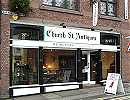Contact Seller
Church Street Antiques
Tel0161 929 5196Please quote Antiques Atlas.


 Minolta AFZ
Minolta AFZ
 This Olympus Trip AF-30 35mm
This Olympus Trip AF-30 35mm
 Olympus Superzoom 70
Olympus Superzoom 70
 An original Genesis, C 1989, an SLR 35 mm camera
An original Genesis, C 1989, an SLR 35 mm camera
 Canon T50
Canon T50
 Corfield 66 Camera
Corfield 66 Camera
 Zeiss Ikon Nettar Camera
Zeiss Ikon Nettar Camera
 Beltica Cludor Folding Camera
Beltica Cludor Folding Camera
 Antique Box Field Camera and Tripod, English
Antique Box Field Camera and Tripod, English
 Three Cameras Zeis Nettar , and Two Yashicas
Three Cameras Zeis Nettar , and Two Yashicas
 Coronet Spy Camera Rare Colours
Coronet Spy Camera Rare Colours
 Rare Vintage Camera Verascope Brevetes Of Paris Su
Rare Vintage Camera Verascope Brevetes Of Paris Su
Non UK callers :
+44 161 929 5196
Edwardian Camera on Tripod Stand


Edwardian Sanderson Ensign half plate camera, on hickory tripod stand, circa 1910 - 24" diam x 65"h set up - Sanderson Cameras
Sanderson cameras, both field and 'Hand and Stand' forms, are based on F.H. Sanderson’s patent of 1895. This describes how the lens board is held between two pairs of slotted struts, a screwed bolt, connected to the lens board, passes between the slots to clamp the lens board to the struts. When unclamped the lens board is free to move vertically, tilt and move forward or backwards. This allowed the photographer to roughly focus and compose the subject, then with the struts unclamped a single movement would move the lens board to critical focus and bring the rising front into play. On later models there would be pre-set catches to set the front standard in a vertical position.
The second aim of the Universal Swing Front was to allow the camera baseboard and therefore the tripod to remain level and do away with the necessity of tilting the camera and tilting the back. When taking subjects such as buildings a problem would be the amount of foreground shown on the screen, to overcome this the photographer would tilt the camera up, this will introduce converging verticals which was remedied by tilting the back so that it was vertical. In Sanderson’s design the camera bed is kept level and the lens is raised, for which there is ample rising front available, and tilted as required. A test took place in Cambridge in 1897, the results were widely reported in the photographic press and substantiate Sanderson’s claim for his camera over the use of tilting back models.
Frederick Herbert Sanderson was born in Cambridge in 1856, he worked as a cabinet maker and wood and stone carver. As a photographer he specialised in architectural subjects, not finding a suitable camera for his purposes led him to design the Universal Swing Front which is the basis of the Sanderson camera. He died in July 1929.
The cameras were sold by Houghton and made by Holmes Brothers of Islington who, at the time, were associated with G. Houghton & Son and later (1904) formed part of Houghtons Ltd.
SellerChurch Street Antiques
View all stock from
Church Street Antiques

 4 Old Market Place
4 Old Market Place
Altrincham
Cheshire
WA14 4NP
Tel : 0161 929 5196
Non UK callers : +44 161 929 5196
Get directions to Church Street Antiques
Sanderson cameras, both field and 'Hand and Stand' forms, are based on F.H. Sanderson’s patent of 1895. This describes how the lens board is held between two pairs of slotted struts, a screwed bolt, connected to the lens board, passes between the slots to clamp the lens board to the struts. When unclamped the lens board is free to move vertically, tilt and move forward or backwards. This allowed the photographer to roughly focus and compose the subject, then with the struts unclamped a single movement would move the lens board to critical focus and bring the rising front into play. On later models there would be pre-set catches to set the front standard in a vertical position.
The second aim of the Universal Swing Front was to allow the camera baseboard and therefore the tripod to remain level and do away with the necessity of tilting the camera and tilting the back. When taking subjects such as buildings a problem would be the amount of foreground shown on the screen, to overcome this the photographer would tilt the camera up, this will introduce converging verticals which was remedied by tilting the back so that it was vertical. In Sanderson’s design the camera bed is kept level and the lens is raised, for which there is ample rising front available, and tilted as required. A test took place in Cambridge in 1897, the results were widely reported in the photographic press and substantiate Sanderson’s claim for his camera over the use of tilting back models.
Frederick Herbert Sanderson was born in Cambridge in 1856, he worked as a cabinet maker and wood and stone carver. As a photographer he specialised in architectural subjects, not finding a suitable camera for his purposes led him to design the Universal Swing Front which is the basis of the Sanderson camera. He died in July 1929.
The cameras were sold by Houghton and made by Holmes Brothers of Islington who, at the time, were associated with G. Houghton & Son and later (1904) formed part of Houghtons Ltd.
Price The price has been listed in British Pounds.
Conversion rates as of 27/MAY/2025. Euro & Dollar prices will vary and should only be used as a guide.
Always confirm final price with dealer.
Category Antique Photography and Photographica
Period Edwardian Antiques
Material Leather
Origin English
Item code as033a3236 / 6485
Status Sold
£1650.00 
$2230.97 
€1966.97 

$

€

Conversion rates as of 27/MAY/2025. Euro & Dollar prices will vary and should only be used as a guide.
Always confirm final price with dealer.
View all stock from
Church Street Antiques

 4 Old Market Place
4 Old Market PlaceAltrincham
Cheshire
WA14 4NP
Tel : 0161 929 5196
Non UK callers : +44 161 929 5196
Get directions to Church Street Antiques
You may also be interested in
 Minolta AFZ
Minolta AFZ
 This Olympus Trip AF-30 35mm
This Olympus Trip AF-30 35mm
 Olympus Superzoom 70
Olympus Superzoom 70
 An original Genesis, C 1989, an SLR 35 mm camera
An original Genesis, C 1989, an SLR 35 mm camera
 Canon T50
Canon T50
 Corfield 66 Camera
Corfield 66 Camera
 Zeiss Ikon Nettar Camera
Zeiss Ikon Nettar Camera
 Beltica Cludor Folding Camera
Beltica Cludor Folding Camera
 Antique Box Field Camera and Tripod, English
Antique Box Field Camera and Tripod, English
 Three Cameras Zeis Nettar , and Two Yashicas
Three Cameras Zeis Nettar , and Two Yashicas
 Coronet Spy Camera Rare Colours
Coronet Spy Camera Rare Colours
 Rare Vintage Camera Verascope Brevetes Of Paris Su
Rare Vintage Camera Verascope Brevetes Of Paris Su







